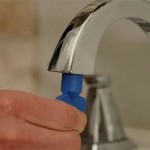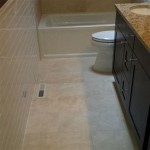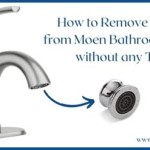How to Remove Scratches from a Bathroom Sink
Scratches on a bathroom sink are a common sight. They can occur due to a variety of reasons, including abrasive cleaning agents, dropped objects, or simply the wear and tear of everyday use. While they may not be a major problem in terms of functionality, unsightly scratches can significantly detract from the aesthetic appeal of your bathroom. Fortunately, there are a number of effective methods for removing scratches from a bathroom sink, depending on the severity of the damage and the type of sink material.
Method 1: Using a Commercial Scratch Remover
For minor scratches, especially on porcelain or ceramic sinks, a commercial scratch remover can be a quick and effective solution. These products typically contain abrasive compounds that work to polish the surface and minimize the appearance of the scratch.
Here's how to use a commercial scratch remover:
-
Clean the sink thoroughly:
Before applying any product, make sure the sink is clean and free of any debris or soap residue. Use a mild cleaner and a soft, non-abrasive sponge to clean the area around the scratch. -
Apply the scratch remover:
Refer to the product's instructions, as application methods can vary. Many products require a small amount to be applied to a soft cloth or sponge, then gently rubbed over the scratch in a circular motion. -
Buff the surface:
Once the product has been applied, use a soft cloth to buff the area, removing any excess product and helping to blend the scratch into the surrounding surface. -
Rinse and dry:
Rinse the sink thoroughly with water and dry it with a clean towel.
While effective for minor scratches, commercial scratch removers may not be suitable for deeper or more extensive damage. Always test the product on a small, inconspicuous area of the sink before applying it to the entire scratch to ensure it doesn't damage the finish.
Method 2: Using Automotive Scratch Remover
For deeper scratches, a car scratch remover can be a suitable alternative. These products are designed to work on a variety of surfaces and can effectively remove more significant scratches. Automotive scratch removers typically contain polishing compounds and abrasives that can smooth out the surface of the sink.
The application process for automotive scratch removers is similar to that of commercial scratch removers:
-
Clean the sink:
Ensure the sink is clean and dry before applying the product. -
Apply the scratch remover:
Apply a small amount of the product to a soft cloth or sponge and rub it gently over the scratch using even pressure in a circular motion. -
Buff the surface:
Buff the area with a clean, soft cloth to remove any excess product and ensure a smooth finish. -
Rinse and dry:
Thoroughly rinse the sink with water and dry it with a clean towel.
Again, always test the product on a small, inconspicuous area of the sink before applying it to the entire scratch.
Method 3: Using Baking Soda and Vinegar
For minor scratches, a simple DIY solution using baking soda and vinegar can be effective. Baking soda is a mild abrasive that can help to polish the surface and make the scratch less noticeable. The vinegar acts as a cleaning agent and helps to neutralize the baking soda.
-
Make the paste:
Combine a small amount of baking soda with a few drops of vinegar. The mixture should form a paste. -
Apply the paste:
Using a soft cloth, apply the paste to the scratch and rub it gently in a circular motion. -
Rinse and dry:
After applying the paste, rinse the sink thoroughly with water and dry it with a clean towel.
This method is particularly effective for minor scratches on porcelain or ceramic sinks. For deeper scratches, it may not be as effective. As with the other methods, always test the paste on a small, inconspicuous area of the sink before applying it to the entire scratch.
Method 4: Using Toothpaste
Similar to baking soda, toothpaste can be used to polish scratches on a bathroom sink. The abrasive properties of toothpaste can help to minimize the appearance of scratches.
Here's how to remove scratches using toothpaste:
-
Use a non-gel toothpaste:
Choose a non-gel toothpaste, as it contains finer abrasives that are more effective for polishing. -
Apply the toothpaste:
Squeeze a small amount of toothpaste onto a soft cloth and apply it to the scratch. -
Rub gently:
Rub the toothpaste gently in a circular motion over the scratch for a few minutes. -
Rinse and dry:
Rinse the sink thoroughly with water and dry it with a clean towel.
While toothpaste is a readily available and convenient option, it may not be as effective as other methods for deeper scratches.
Remember to always clean the sink thoroughly before and after using any of these methods. Also, it's important to use a soft cloth or sponge to avoid further damaging the surface. By following these tips, you can effectively remove scratches from your bathroom sink and restore its original shine.
How To Remove Scratches From A Porcelain Sink In 2024
Remove Scratches From A Porcelain Sink

4 Expert Ways To Remove Black Scuff Marks From A Porcelain Kitchen Sink Everyday Old House

How To Get Rid Of Black Scratch Marks On White Porcelain Sink Hometalk

How To Remove Light Scratches From Pretty Much Anything Stratagem

4 Expert Ways To Remove Black Scuff Marks From A Porcelain Kitchen Sink Everyday Old House

How To Remove Scratches From A Composite Granite Sink Kitchen Sinks Stylish International Inc

How To Get Rid Of Black Scratch Marks On White Porcelain Sink Hometalk

4 Expert Ways To Remove Black Scuff Marks From A Porcelain Kitchen Sink Everyday Old House

How To Fix Scratches On Sink Counter Top In Bathroom Doityourself Com Community Forums
Related Posts







